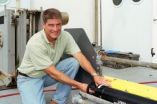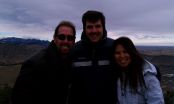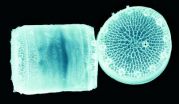(Press-News.org) A University of Delaware oceanographer has stumbled upon an unusual aid for studying local waterways: radioactive iodine. Trace amounts of the contaminant, which is used in medical treatments, are entering waterways via wastewater treatment systems and providing a new way to track where and how substances travel through rivers to the ocean.
"This is a really interesting convergence of medicine, public health and environmental science," said Christopher Sommerfield, associate professor of oceanography in UD's College of Earth, Ocean, and Environment.
Sommerfield found small quantities of radioactive iodine, also called radioiodine or I-131, by accident while sampling the Delaware River, the main source of freshwater to Delaware Bay. The amounts were at low concentrations that do not pose a threat to humans or the environment, according to the Environmental Protection Agency (EPA).
Sommerfield measures naturally occurring radionuclides, variants of elements emitting radiation, that attach to mud particles carried along by water. The work is part of his research on how river sediments move through estuaries to the coastal ocean and influence the sea floor and coast.
When I-131 showed up in his samples, he thought it was a mistake.
"I-131 is a man-made radionuclide produced in nuclear reactors, so when we first detected it my heart skipped a beat," Sommerfield said. "However, after further research and consultation with government experts, I realized that it was I-131 waste from thyroid cancer treatments."
Therapeutic I-131 administered at hospitals enters urban sewage after thyroid cancer patients return home and excrete the medicine. Last summer the Philadelphia Water Department discovered extremely low levels of I-131 in the Schuylkill River, which serves as a drinking water source for the city, in samples collected following the Fukushima nuclear disaster in Japan.
The department determined that the substance was coming from local medical treatments. Like the amounts Sommerfield found throughout the Delaware Estuary around the same time, the levels were well below the maximum accepted level set by the EPA, which periodically monitors I-131 at a limited number of sites.
Sommerfield shared his findings with Philadelphia and Delaware officials, who continue to examine the situation. He discovered that the highest I-131 concentrations were present in the highly urbanized section of the Delaware River, which receives a large amount of treated wastewater from municipalities, and that levels steadily decreased downstream to zero in Delaware Bay.
I-131 has a half-life of eight days, meaning its radioactivity decreases by half during that time period as it transforms to non-radioactive elements. Sommerfield was unable to find much information about the fate of I-131 in coastal waterways.
"There are only a few recent research papers documenting the behavior I-131 in rivers and estuaries worldwide, and nothing for Delaware," he said.
Sommerfield recently shared his experience at the international Ocean Sciences Meeting in Utah, where fellow researchers were interested in learning more about how I-131 could be used as a water and sediment tracer. Radionuclides help oceanographers study transport processes in estuaries and coastal waters, and I-131 has the potential to fill a void among natural and man-made radionuclides that are typically measured because it has a very short half-life and comes from a specific source.
"Wastewater-derived I-131 provides a tool to better understand how estuaries disperse water and suspended particles," Sommerfield said. "With further research, we expect to learn more about how sediment from the Delaware River is delivered to the estuary and fringing tidal marshlands, which require muddy sediments for nutrients and stability."
INFORMATION:
This research is funded by the National Science Foundation and Delaware Sea Grant.
Sediment sleuthing
Radioactive medicine being tracked through rivers
2012-03-26
ELSE PRESS RELEASES FROM THIS DATE:
PryMarke, LLC Signs Additional Book Contracts
2012-03-26
Today the Michigan-based business analytics firm, PryMarke, announced the signing of two book contracts with publisher IGI Global of Pennsylvania. The first book titled, "Cultural and Technological Influences on Global Business", will be an advanced edition of the company's first publication, "Cultural Variations and Business Performance: Contemporary Globalism", which was released this month worldwide via Amazon.com and local book stores. The second book titled, "Transcultural Human Capital for Competitive Global Business", will be a human ...
MIT graduate students head to Capitol Hill to deliver petition in support of research funding
2012-03-26
Washington, DC – March 22, 2012 – A contingent of science and engineering graduate students from the Massachusetts Institute of Technology will deliver a petition in support of research funding to members of Congress on Tuesday, March 27, 2012. Stand With Science is an effort to bring together America's science and engineering graduate community and add their voice to the ongoing discussion about the federal deficit. (www.standwithscience.com)
"Stand With Science has drafted a letter to the members of congress, urging them to maintain science and engineering funding ...
Top Internet Marketer Scotti Blair Finishes his First Day of the A.F.L. in Hasbrouck Heights NJ
2012-03-26
Scotti arrived in Hasbrouck Heights late on Friday night and right away knew he was in good company. He started with a little dinner and met his peer Greg also attending the A.F.L. the following morning. When the alarm went off it was up to start the journey of being the next top internet marketer in his field. Among those that attended were Aaron and Sophia Rashkin and members from the loyal 9 some of the top dogs in the business. Off to a great start he learn and absorb more than the normal truck driver from a small town.
A short shuttle ride and the day had began, ...
Standoff sensing enters new realm with dual-laser technique
2012-03-26
Identifying chemicals from a distance could take a step forward with the introduction of a two-laser system being developed at the Department of Energy's Oak Ridge National Laboratory.
In a paper published in the Journal of Physics D: Applied Physics, Ali Passian and colleagues present a technique that uses a quantum cascade laser to "pump," or strike, a target, and another laser to monitor the material's response as a result of temperature-induced changes. That information allows for the rapid identification of chemicals and biological agents.
"With two lasers, one ...
Scientists reprogram cancer cells with low doses of epigenetic drugs
2012-03-26
Experimenting with cells in culture, researchers at the Johns Hopkins Kimmel Cancer Center have breathed possible new life into two drugs once considered too toxic for human cancer treatment. The drugs, azacitidine (AZA) and decitabine (DAC), are epigenetic-targeted drugs and work to correct cancer-causing alterations that modify DNA.
The researchers said the drugs also were found to take aim at a small but dangerous subpopulation of self-renewing cells, sometimes referred to as cancer stem cells, which evade most cancer drugs and cause recurrence and spread.
In a ...
Eric Omand Attended AFL Mastermind This Past Weekend With Top Earning Online Entrepreneurs in New Jersey
2012-03-26
Top earning online entrepreneurs Aaron Rashkin and Sohia Rashkin as well as the Loyal 9 Revolution (Justin Woolf, Kevin Levonas, Anthony Busciglio, Jordon Crowder, Frank Scott, and Benny Bells) hosted the Legacy Mastermind this past weekend in Hasbrouck Heights, NJ. The Legacy Mastermind was all about taking action and the implementation of the nuts and bolts required to create a seven figure a year online business.
The same online leaders have hosted mastermind events in the past and all graduates report that their businesses have been catapulted as a result. 20 online ...
Pulp NonFiction: Fungal analysis reveals clues for targeted biomass deconstruction
2012-03-26
Without fungi and microbes to break down dead trees and leaf litter in nature, the forest floor might look like a scene from TV's "Hoarders."
Massive-scale genome sequencing projects supported by the U.S. Department of Energy (DOE) and being carried out at the DOE Joint Genome Institute (JGI) highlight the importance of learning how the cellulose, hemicellulose and lignin that serve as a plant's infrastructure can be broken down by these forest organisms to extract needed nutrients. Among the fungi being studied are species that can selectively break down the cell wall ...
Mayo Clinic-TGen study role testosterone may play in triple negative breast cancer
2012-03-26
SCOTTSDALE, Ariz. -- Could blocking a testosterone receptor lead to a new way to treat an aggressive form of breast cancer? That's a question researchers at Mayo Clinic in Arizona and the Translational Genomics Research Institute (TGen) are exploring. Preliminary results of a Mayo Clinic - TGen collaborative study shows the testosterone receptor may be a potential target to attack in treating triple negative breast cancer (TNBC).
Lead researcher Barbara Pockaj, M.D., a surgical oncologist at Mayo Clinic in Arizona will present the results of the study at the 65th annual ...
Magnetic field researchers target 100-tesla goal
2012-03-26
LOS ALAMOS, New Mexico, March 22, 2012 -- Researchers at Los Alamos National Laboratory's biggest magnet facility today met the grand challenge of producing magnetic fields in excess of 100 tesla while conducting six different experiments. The hundred-tesla level is roughly equivalent to 2 million times Earth's magnetic field.
"This is our moon shot, we've worked toward this for a decade and a half," said Chuck Mielke, director of the Pulsed Field Facility at Los Alamos.
The team used the 100-tesla pulsed, multi-shot magnet, a combination of seven coils sets weighing ...
Diatom biosensor could shine light on future nanomaterials
2012-03-26
SEQUIM, Wash. – A glow coming from the glassy shell of microscopic marine algae called diatoms could someday help us detect chemicals and other substances in water samples. And the fact that this diatom can glow in response to an external substance could also help researchers develop a variety of new, diatom-inspired nanomaterials that could solve problems in sensing, catalysis and environmental remediation.
Fluorescence is the key characteristic of a new biosensor developed by researchers at the Department of Energy's Pacific Northwest National Laboratory. The biosensor, ...
LAST 30 PRESS RELEASES:
Low daily alcohol intake linked to 50% heightened mouth cancer risk in India
American Meteorological Society announces Rick Spinrad as 2026 President-Elect
Biomass-based carbon capture spotlighted in newly released global climate webinar recording
Illuminating invisible nano pollutants: advanced bioimaging tracks the full journey of emerging nanoscale contaminants in living systems
How does age affect recovery from spinal cord injury?
Novel AI tool offers prognosis for patients with head and neck cancer
Fathers’ microplastic exposure tied to their children’s metabolic problems
Research validates laboratory model for studying high-grade serous ovarian cancer
SIR 2026 delivers transformative breakthroughs in minimally invasive medicine to improve patient care
Stem Cell Reports most downloaded papers of 2025 highlight the breadth and impact of stem cell research
Oxford-led study estimates NHS spends around 3% of its primary and secondary care budget on the health impacts of heat and cold in England
A researcher’s long quest leads to a smart composite breakthrough
Urban wild bees act as “microbial sensors” of city health.
New study finds where you live affects recovery after a hip fracture
Forecasting the impact of fully automated vehicle adoption on US road traffic injuries
Alcohol-related hospitalizations from 2016 to 2022
Semaglutide and hospitalizations in patients with obesity and established cardiovascular disease
Researchers ‘listen in’ to embryo-mother interactions during implantation using a culture system replicating the womb lining
How changing your diet could help save the world
How to make AI truly scalable and reliable for real-time traffic assignment?
Beyond fragmented markets: A new framework for efficient and stable ride-pooling
Can shape priors make road perception more reliable for autonomous driving?
AI tracks nearly 100 years of aging research, revealing key trends and gaps
Innovative techniques enable Italy’s first imaging of individual trapped atoms
KIER successfully develops Korea-made “calibration thermoelectric module” for measuring thermoelectric device performance
Diversifying US Midwest farming for stability and resilience
Emphasizing immigrants’ deservingness shifts attitudes
Japanese eels, climate change, and river temperature
Pusan National University researchers discover faster, smarter heat treatment for lightweight magnesium metals
China’s 2024 Gastroenterology Report: marked progress in endoscopy quality and disease management
[Press-News.org] Sediment sleuthingRadioactive medicine being tracked through rivers


